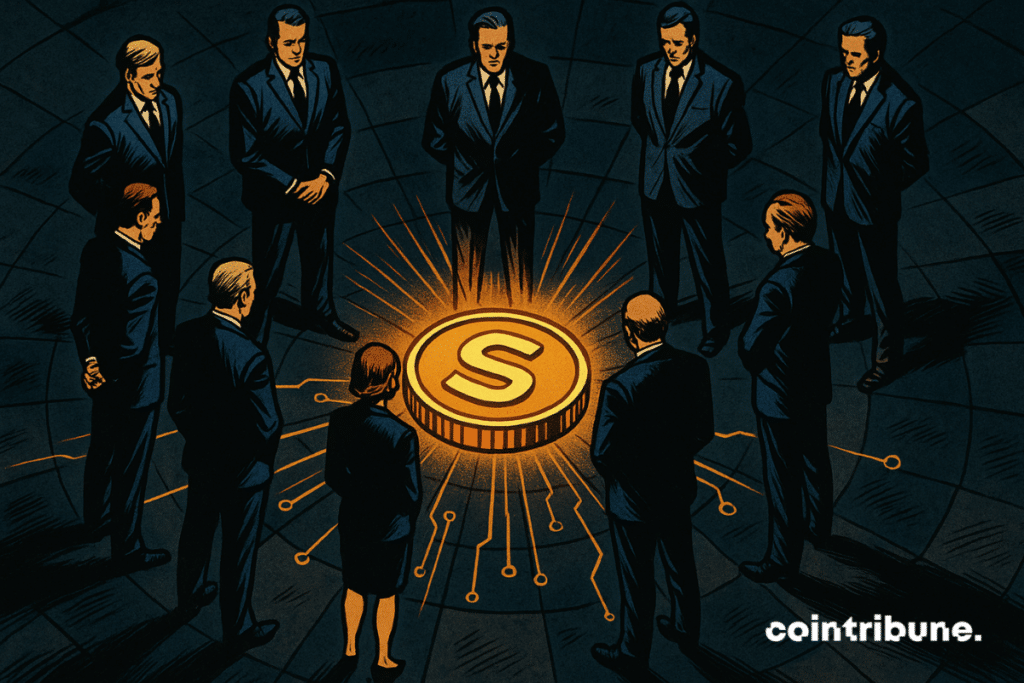— Goku 🗞 (@Crypto__Goku) October 10, 2025
A
A
Banks Join Crypto : Stablecoin Pilot Backed By G7 Currencies
Fri 10 Oct 2025 ▪
4
min read ▪ by
Getting informed
▪
Stablecoin
Summarize this article with:
Faced with the uncontrolled rise of private stablecoins, the global banking giants, from Goldman Sachs to Société Générale, are going on the offensive. By testing tokens backed by G7 currencies, these institutions aim to regain control of digital finance. This strategic project, led by the USDF consortium and the Provenance blockchain, seeks to combine monetary stability, regulatory compliance, and technological innovation. Such an initiative could redefine the balance between traditional banks, regulators, and the crypto ecosystem.

In brief
- Several major global banks, including JPMorgan, Goldman Sachs, and UBS, launch a joint initiative around stablecoins.
- The project aims to create stable digital currencies, backed by G7 currencies, to modernize interbank payments.
- These stablecoins would be issued via public blockchains and guaranteed by insured bank deposits.
- The initiative is intended to comply with regulatory requirements, with enhanced governance and full traceability.
The major banks take a stand : towards a standardization of institutional stablecoins?
While the dominance of USDT and USDC stablecoins falls to 83 %, a group of major global banks is currently working on issuing stablecoins backed by currencies such as the dollar, euro, British pound, and yen.
This project is led by the USDF consortium, based in the United States, in partnership with the public blockchain network Provenance Blockchain. The goal is to “provide a compliant and interoperable institutional settlement solution backed by insured bank deposits”, stated Figure Technologies, one of the key players involved in the consortium.
The initiative aims to create a regulated alternative to stablecoins issued by non-bank entities. The key points of the project include :
- A backing by G7 currencies via guaranteed bank deposits, which strengthens the stability of issued tokens ;
- Issuance through traditional banks such as JPMorgan, Goldman Sachs, UBS, or Deutsche Bank, offering increased institutional credibility ;
- The use of public blockchains to ensure transparency and traceability of transactions ;
- Enhanced regulatory compliance to meet the requirements of U.S. and international financial authorities.
By positioning themselves in the stablecoin market, these institutions aim to regain control of a segment so far dominated by the crypto ecosystem. They also seek to reduce frictions in cross-border settlements while offering a safer solution to institutional players.
Towards a redefinition of monetary flows ?
If this initiative materializes on a large scale, the consequences could be considerable, especially for banking systems in emerging countries. A recent study, conducted by Standard Chartered using on-chain data, warns of the risk that dollar-backed stablecoins pose to fragile economies: “up to $1,000 billion could leave local banks over the next three years if these stablecoins become widespread,” according to the bank’s analysts.
At the same time, JPMorgan estimates that the rise of these assets could generate an additional $1.4 trillion demand for the greenback by 2027. This dynamic strengthens the hegemony of the dollar in the digital economy, to the detriment of other currencies.
Europe, meanwhile, is trying to react. Indeed, eurozone finance ministers are already considering mechanisms to encourage the emergence of stablecoins denominated in euros, to counterbalance this American dominance. In the longer term, the European Central Bank is considering a cap of €3,000 per individual to limit systemic risks related to the future digital euro.
Maximize your Cointribune experience with our "Read to Earn" program! For every article you read, earn points and access exclusive rewards. Sign up now and start earning benefits.
A
A
Diplômé de Sciences Po Toulouse et titulaire d'une certification consultant blockchain délivrée par Alyra, j'ai rejoint l'aventure Cointribune en 2019. Convaincu du potentiel de la blockchain pour transformer de nombreux secteurs de l'économie, j'ai pris l'engagement de sensibiliser et d'informer le grand public sur cet écosystème en constante évolution. Mon objectif est de permettre à chacun de mieux comprendre la blockchain et de saisir les opportunités qu'elle offre. Je m'efforce chaque jour de fournir une analyse objective de l'actualité, de décrypter les tendances du marché, de relayer les dernières innovations technologiques et de mettre en perspective les enjeux économiques et sociétaux de cette révolution en marche.
DISCLAIMER
The views, thoughts, and opinions expressed in this article belong solely to the author, and should not be taken as investment advice. Do your own research before taking any investment decisions.